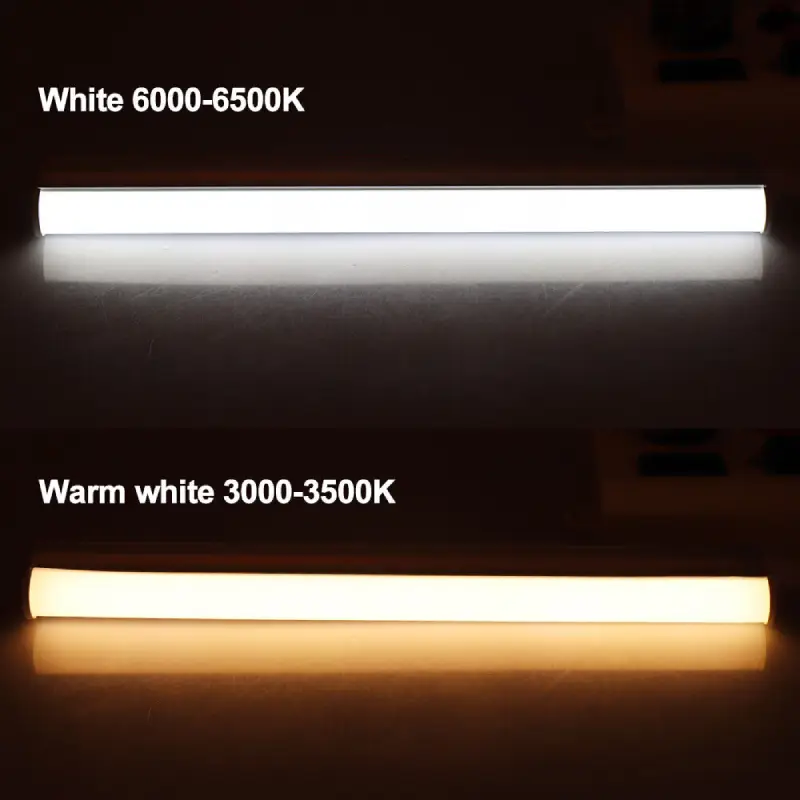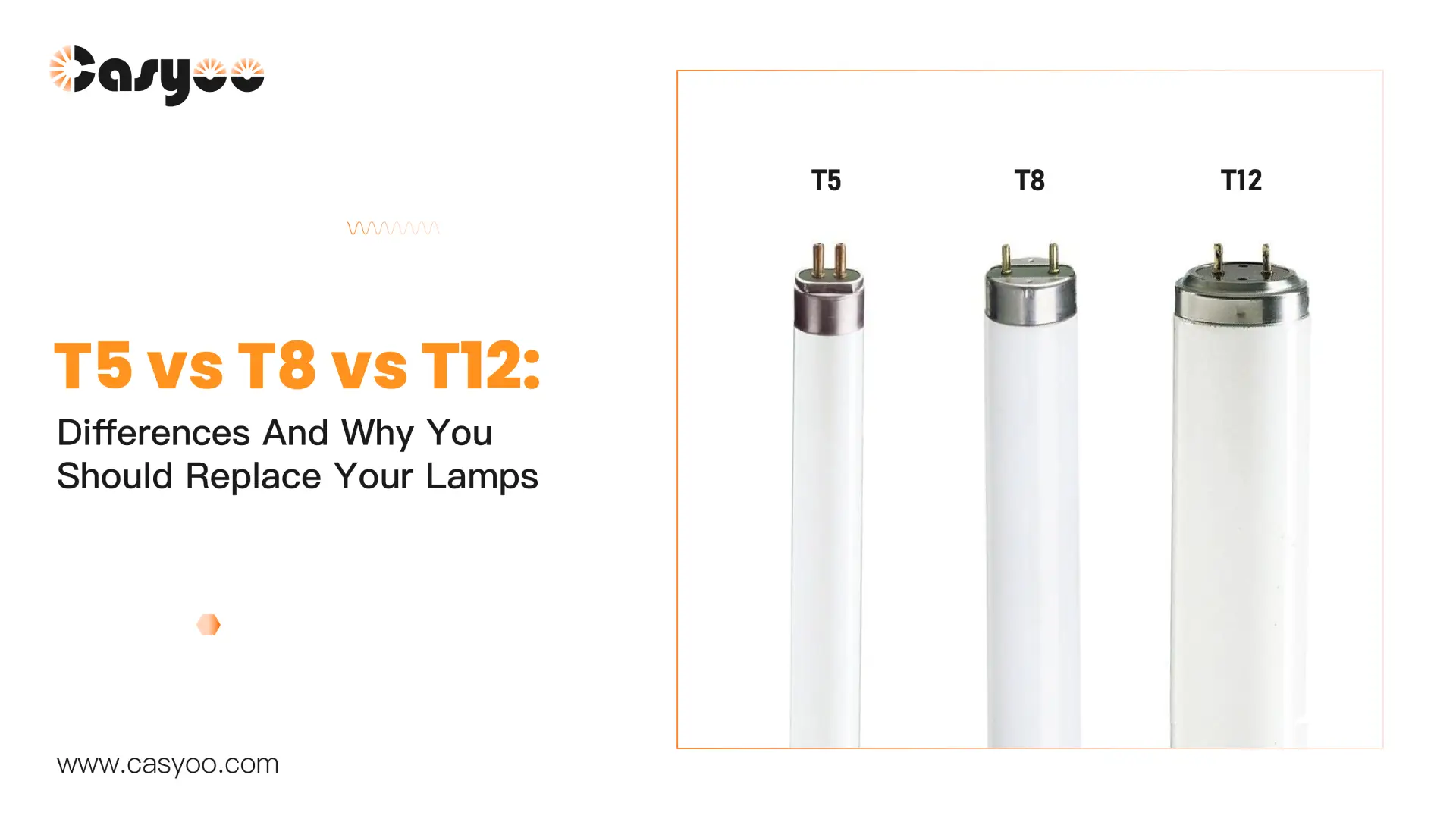You can find fluorescent or LED tubes everywhere for different uses. And if you own the tubes yourself, you must have heard the three main types of these tubes: T5, T8, and T12. Do you know their differences in size, lifespan, efficiency, CRI, and application? And do you need to replace these lights with LED lights when the fluorescent lights are gradually phased out? Read on for more about T5 vs T8 vs T12 lamps!
T5 vs T8 vs T12: What are the differences?
As early as 2012, many countries around the world had issued laws to ban the use of T12 lamps due to their low efficiency and negative impact on the environment. Nowadays, it’s rare to find T12 lamps on the market. In the following passage, we will mainly help you understand the difference between t5 and t8 fluorescent lamps and LED lamps.
Size
“T” stands for “tube,” and the number that follows T shows the lamp tube’s diameter. T1 means that the diameter of the lamp is one eighth of an inch. The tubes’ length changes in proportion to the lamp’s wattage. The common sizes of the tubes are shown in the following table.
| Type | Diameter | Common watt | Length (mm) |
| T5 | 5/8 inch (15mm) | 8 | 310 |
| 14 | 570 | ||
| 21 | 870.5 | ||
| 28 | 1170.5 | ||
| 35 | 1475 | ||
| T8 | 1 inch (25mm) | 20 | 620 |
| 30 | 926 | ||
| 40 | 1230 | ||
| T12 | 12/8 inch (40mm) | 60 | 1219.2 |
Lifespan
- T8 fluorescent tubes: The service life of T8 lamps is 6,000 to 8,000 hours.
- T5 fluorescent tubes: T5 lamps are improved with new technology, so they are more durable than T8 lamps, and they can work for 10,000 to 20,000 hours. The lifespan of fluorescent tubes is also related to how you use the lamps. The lamp’s lifespan will be reduced if it is turned on and off frequently.
- LED tubes: LED lamps use solid light sources to emit light, while fluorescent lamps use gas to discharge and emit light. Therefore, its lifespan is much longer, which can generally be more than 50,000 hours.
Efficiency
- T8 fluorescent tubes: The main luminous material of T8 fluorescent lamp is halogen powder. Halogen powder is cheap, but its luminous efficiency is Besides, it also has poor thermal stability, obvious light decay, and a low luminous maintenance rate. Typical T8 fluorescent bulbs have a luminous efficiency of roughly 70 lm/w, while the efficiency of T12 fluorescent lamps is about 60 lm/w.
- T5 fluorescent tubes: The most important improvement of T5 tubes is to use rare earth phosphor to emit light. This phosphor can emit the three basic colors of red, green, and blue, which become daylight colors after mixing. The human eye is sensitive to this mixed light, so this type of lamp looks brighter. Rare earth phosphor has high luminous efficiency, with an average efficiency of more than 80 lm/w, which is about 5 times that of an incandescent lamp. In addition, because the diameter of T5 tubes is much thinner than that of T8 and T12 tubes, the collision probability between the inert gas atoms filled in the tube and the electrons is higher. Because of this, there is less energy loss, which helps to increase efficiency. Compared with T12 and T8 fluorescent lamps, T5 lamps can greatly save energy.
- LED lamps: The current luminous efficiency of LED lamps can reach about 100-120 lm/w. Compared with LED lamps, fluorescent lamps have lower luminous efficiency, and the ballast they need also consumes some electricity. In addition, LED experts keep improving the luminous efficiency of LED lights, and the price is constantly decreasing. On the contrary, the efficiency of fluorescent lamps cannot be improved any more. Therefore, the advantages of LED lamps will become more and more obvious.
Color temperature and CRI
- T8/T12 fluorescent lamps: These fluorescent tubes are coated with halogen phosphor and filled with argon and krypton-argon mixed gas. There are usually two types of color temperature of their light: cold white daylight and warm white light. These two types of light have low color rendering performance, and their CRI can be less than 40. The color of objects under this kind of light will be dull and dark.
- T5 fluorescent tubes: T5 fluorescent tubes are coated with rare earth phosphors and filled with gas that emits light with high efficiency. The tri-primary colors combine into sunlight color, making the light have a high CRI, which can reach 80.
- LED lamps: The CRI of LED lamps ranges from 80 to 90 because the light contains a wide spectrum like sunlight. As for color temperature, those LED lamps that emit light with their RGB chips can provide a wide range of color temperatures, from daylight to warm white.

Application
- T8 fluorescent lamps: T8 lamps are widely used in public areas, such as factories, hospitals, government agencies, bus stations, etc., because it is easy to integrate T8 tubes with built-in power supplies. Because of the T5’s small diameter, its power supply is usually built-in through integration or directly externalized. Therefore, compared with T8, the replacement of T5 is more complicated.
- T5 fluorescent tubes:For home lighting, T5 is better than T8. For example, ceiling lighting generally uses soft light strips or T5 lamps for decorative lighting.
- LED lamps: LED lamps can be used almost everywhere, no matter for indoor or outdoor lighting. They have an IP 65 waterproof rating and emit little heat, thus suitable for working in harsh weather.
Ballast
- T8 fluorescent lamps:Fluorescent lamps with a tube diameter larger than T8 (including T8) require a lower starting voltage, so the lamps can be started with an inductive ballast.
- T5 fluorescent tubes:Fluorescent lamps with a tube diameter smaller than T8 require a higher starting voltage, so they must work with an electronic ballast. The electronic ballast generates a high starting voltage to ignite the gas inside the fluorescent lamp.
- LED lamps: LED lamps use chips instead of gas to emit light. Therefore, they don’t need ballast or starter. They are powered by constant current power supply.
Are T12/T8/T5 lamps being phased out?
As we mentioned above, T12 lamps have been phased out since 2012 because of their low efficiency. The most common T8/T5 lamps are also fluorescent lamps, and their efficiency is not high enough either. Besides, the mercury inside these lights will do harm to the environment. Thus, at the Fifth Conference of the Parties to the Minamata Convention on Mercury (COP-5), which took place in 2023, nations from all over the world decided to gradually phase out fluorescent lights starting in 2025 and moving up to 2027. Many countries have already carried out the ban on fluorescent lamps, such as European Union countries, America, China, etc.
Replacing T8 lamps with T5 lamps
On average, T5 tubes are 5 cm shorter than T8 tubes (different lamps may have different lengths and interfaces), so when you want to replace the lamps, you need to fully consider the size of the tubes. You will need a conversion bracket when switching out T8 lights for T5 ones. Besides, you also need to change the ballast into an electronic one.
Replacing fluorescent lamps with LED lamps
With fluorescent lighting banned, LED lights have emerged as the best option. LED lamps are much more efficient than fluorescent lamps and their efficiency is still improving. Replacing fluorescent lamps with LED lamps is relatively simple, but it is recommended to operate under the guidance of experienced professionals. The following are brief steps for replacement:
- Cutoff the power.
- Pull out the old lamp tube and open the bracket cover.
- Unscrew the starter and unplug the two wires connected to the ballast terminals.
- Connect the two wires pulled out from the ballast together to short-circuit the ballast, and wrap the interface with electrical tape to prevent leakage.
- Install the bracket cover back and the new LED lamp tube. You don’t need the starter any more.
T5 vs T8 vs T12: Frequently asked questions
T8 vs T12 bulb: Can I use a T8 bulb in a T12 fixture?
Yes, but with modifications. You must either install a T8-compatible electronic ballast or implement a hybrid ballast for fixtures that have T12 magnetic ballasts.
T8 vs T12 ballast: How to tell if ballast is T8 or T12?
The weight and bulkiness of electromagnetic T12 ballasts differs from the compact and lightweight electronic T8 ballasts. Alternatively, T8 ballasts often support dimming, while T12 ballasts do not.
Are t8 and t12 pins the same?
Yes! Both T8 and T12 tubes use bi-pin bases (G13 type) with the same pin spacing (12.7mm/0.5 inches). However, when fitted into a T12 fixture T8 bulbs appear loose because their 1-inch diameter is smaller than the 1.5-inch T12 bulb diameter without adapter support.
T5 vs T8 vs T12: Conclusion
T5, T8, T12 lamps vary in size, lifespan, efficiency, CRI, color temperature, and ballast. T12 fluorescent lamps have been phased out for a long time, and although T5 fluorescent lamps emerged as the updated version of T8 and T12 lamps, they will soon be banned as well. It is recommended to change the fluorescent lamps into LED ones for higher efficiency and less negative influence on the environment. For more advice on fluorescent lamps and LED lamps, contact us now!




